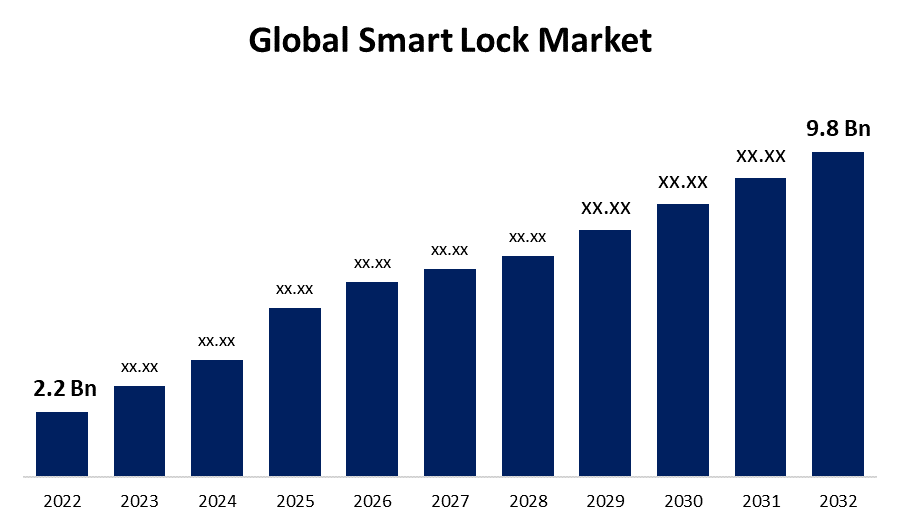Global Smart Lock Market Size, Share, and COVID-19 Impact Analysis, By Type (Deadbolt, Lever Handles, Padlock, Others), By Product (Biometric Door Locks (Face Recognition, Palm Recognition, Iris Recognition, Fingerprint Recognition) Smart Card Door Locks, Electric Strike Door Locks, Others), By Connectivity (Wi-Fi, Bluetooth, ZigBee, Others), By End-User (Residential, Hospitality, Commercials, Government, Retail, Others) and By Region (North America, Europe, Asia-Pacific, Latin America, Middle East, and Africa), Analysis and Forecast 2022 – 2032
Industry: Information & TechnologyGlobal Smart Lock Market Insights Forecasts to 2032
- The Global Smart Lock Market Size was valued at USD 2.2 Billion in 2022.
- The Market is Growing at a CAGR of 16.11% from 2022 to 2032
- The Worldwide Smart Lock Market is expected to reach USD 9.8 Billion by 2032
- Asia Pacific is expected to Grow the fastest during the forecast period

Get more details on this report -
The Global Smart Lock Market Size is expected to reach USD 9.8 Billion by 2032, at a CAGR of 16.11% during the forecast period 2022 to 2032.
A smart lock is an advanced version of a standard lock. This lock is a Bluetooth or Wi-Fi-enabled smart home gadget that allows users to lock and unlock doors with the touch of a finger or a simple voice command. The smart door lock can be operated wirelessly by a cryptographic key after authentication, allowing only those who are authorized access. As customers frequently prefer improved locking/unlocking systems, such improvements are projected to increase the popularity of smart locks. There is a growing requirement for advanced security solutions to protect various assets such as individual houses, hotels, supermarkets, banks, financial institutions, corporate buildings, and commercial buildings. Another common application for smart locks is in the hospitality business. To improve the security of their homes, several hotels have planned to use Wi-Fi or Bluetooth-enabled locks instead of Radio-frequency identification (RFID) locks accessed by integrated circuits (IC) cards. which is projected to drive the market during the forecast period.
Global Smart Lock Market Report Coverage
| Report Coverage | Details |
|---|---|
| Base Year: | 2022 |
| Market Size in 2022: | USD 2.2 Billion |
| Forecast Period: | 2022-2032 |
| Forecast Period CAGR 2022-2032 : | 16.11% |
| 2032 Value Projection: | USD 9.8 Billion |
| Historical Data for: | 2018-2021 |
| No. of Pages: | 200 |
| Tables, Charts & Figures: | 100 |
| Segments covered: | By Type, By Product, By Connectivity, By End-User and By Region |
| Companies covered:: | ASSA ABLOY, Samsung Group, Panasonic Corporation, Guangdong Be-Tech Security Systems, Honeywell International, Inc., DESSMANN, The Chamberlain Group, Inc., Kaadas, Masterlock, August Home, Kwikset, Techlicious LLC., Godrej Group, Adel Marketing (M) Sdn. Bhd., SCHLAGE, HavenLock, Inc., YALE, Xiaomi Corporation, Latchable, Inc., and Others. |
| Pitfalls & Challenges: | COVID-19 Empact, Challenges, Future, Growth, & Analysis |
Get more details on this report -
Driving Factors
The growing security concern is the primary factor driving the increased use of smart locks. Smart locks have advanced to provide effective and user-friendly services since their development. Furthermore, as many individuals want access to the same facility, the new smart lock launches designed for enterprises and office spaces have tremendous growth potential. The requirement for increased security has driven management to streamline the procedure of unlocking doors for authorized individuals. In spite of their high efficiency and sophistication, they have been used in a variety of locations to improve security. Individual homes, condominiums, hotels, retail establishments, banks and financial institutions, corporate structures, and commercial buildings all have an increasing demand for identity and verification. As a result, security concerns driving the global smart lock market.
Restraining Factors
The switching cost of smart locks is high, making it less attractive for consumers to invest in. Consumers' view of the reliability of smart locks is further compromised by the possibility of hackers. Smart locks might become vulnerable to hackers if they are not regularly updated. Because they are electrical gadgets, they can be disrupted by cyber attackers who can generate phony access codes using smartphones. In addition, as many smart lock models work on battery or electricity, a power outage could hamper their operation and make them vulnerable. As a result, the high cost and general unreliability act as market restrictions.
Market Segmentation
By Type Insights
The deadbolt segment dominates the market with the largest revenue share more than 43.8% over the forecast period.
Based on type, the global smart lock market is segmented into deadbolts, lever handles, padlocks, and others. Among these, the military & defense segment is dominating the market with the largest revenue share more than 43.8% over the forecast period. This growth can be attributed to the product's increasing implementation across multiple industries and its simple method of installation. Low installation costs, great durability, and appropriate security measures all contribute to the expansion of the lock market. Furthermore, businesses are focusing on growing their product portfolio. Kwikset, for example, developed their line of revolutionary deadbolts with built-in features such as single-touch locks, low battery warnings, and specific user codes, which ultimately acquired a large number of customers.
By Product Insights
The biometric segment is witnessing significant CAGR growth over the forecast period.
Based on product, the global smart lock market is segmented into biometrics (face recognition, palm recognition, iris recognition, fingerprint recognition) smart card door locks, electric strike door locks, and others. Among these, the biometric segment is witnessing significant CAGR growth over the forecast period. The fingerprint recognition technology is used in the touch-based unlocking mechanism of smart locks. Fingerprint recognition is a quick and simple method of identifying and authenticating persons. Biometric authentication can provide substantial value to modern home security systems while supporting the rising smart house trend. Biometric authentication, instead of password-protected smart locks, uses personally identifiable information stored securely on-device (whether the lock itself or a fingerprint-secured access card) for optimum security. As a result, biometrics are difficult to hack.
By Connectivity Insights
The Bluetooth segment is expected to hold the rapid revenue growth of the global smart lock market during the forecast period.
Based on the connectivity, the global smart lock market is classified into Wi-Fi, Bluetooth, ZigBee, and others. Among these, the Bluetooth segment is expected to grow at a rapid pace during the forecast period. As Bluetooth smart locks have a limited 300-foot range, user can only operate their locks while they are close to their houses. It is a practical technology that may be used for many different kinds of applications, including asset security, jewelry storage, and access control. It is a low-cost and affordable smart lock setup that provides consumers with convenience and security. This element is driving the growth of the smart locks market during the forecast period.
By End-Users Insights
The residential segment is projected to grow at the highest CAGR in the market during the forecast period.
Based on end-users, the global smart lock market is segmented into residential, hospitality, commercials, government, retail, and others. Among these, the residential segment grows at the highest CAGR growth over the forecast period. Its significant revenue making can be attributed to rising global smart home usage as well as a rise in new construction and restoration projects in recent years. The increased affordability of modern safety measures such as motion detectors, door and window opening sensors, and remote door locking and unlocking is projected to promote even greater use. The development of locks compatible with technologies such as Z-Wave, ZigBee, and BLE is gaining adherence, particularly for mass-market residential applications, attracting different kinds of customers.
Regional Insights
North America dominates the market with the largest market share over the forecast period.

Get more details on this report -
North America is dominating the largest market share over the forecast period, owing to advancements in smart locks technology. This is mostly due to extensive technological use and the rapid adoption of smart homes in the U.S. For instance, over 30% of internet homes in the United States intend to purchase a smart lock by the end of 2023. Customers' considerable spending power, combined with growing safety concerns, particularly in critical infrastructure and domestic applications, has resulted in a regulatory climate that encourages their use. Customers' huge spending power in the region, along with rising security concerns, particularly in critical infrastructure and residential applications, has resulted in an appealing regulatory environment for smart lock sales.
Asia Pacific is expected to register the fastest CAGR growth rate during the forecast period. Significant growth could be ascribed to an increase in the number of residential and commercial constructions, as well as ongoing smart city schemes in developing nations such as India. Furthermore, smart home penetration is growing significantly across the region, which is critical in raising awareness about new devices and technology. Several APAC players are continually developing new features for smart locks. Furthermore, several new start-up companies are testing new smart lock applications to improve safety.
Europe is expected substantial CAGR growth during the projection period. This growth can be attributed to increased investment in developing security door locks for government and crucial infrastructure spaces in nations such as the United Kingdom, France, Benelux, the Nordics, and Germany.
List of Key Market Players
- ASSA ABLOY
- Samsung Group
- Panasonic Corporation
- Guangdong Be-Tech Security Systems
- Honeywell International, Inc.
- DESSMANN
- The Chamberlain Group, Inc.
- Kaadas
- Masterlock
- August Home
- Kwikset
- Techlicious LLC.
- Godrej Group
- Adel Marketing (M) Sdn. Bhd.
- SCHLAGE
- HavenLock, Inc.
- YALE
- Xiaomi Corporation
- Latchable, Inc.
Key Market Developments
- In April 2023, ASSA ABLOY Group, a global leader in access solutions, finished a unique South African assignment to secure businesses and households around the world using its smart lock technology.
- In March 2023, On the ISC West program, Kwikset introduced the Home Connect 620 smart lock. This smart lock includes features including a 10-button keypad and one-touch locking, allowing dealers to integrate safety into smart home environments.
- In February 2023, Yale Home collaborated with Pantone, an American limited liability firm, to introduce PANTONE Viva Magenta, a Pantone color, to a Yale Assure Lock 2 model without compromising the simplicity or security of a smart lock.
Market Segment
This study forecasts revenue at global, regional, and country levels from 2022 to 2032. Spherical Insights has segmented the global smart lock market based on the below-mentioned segments:
Smart Lock Market, Type Analysis
- Deadbolt
- Lever Handles
- Padlock
- Others
Smart Lock Market, Product Analysis
- Biometric Door Locks
- Face Recognition
- Palm Recognition
- Iris Recognition
- Fingerprint Recognition
- Smart Card Door Locks
- Electric Strike Door Locks
- Others
Smart Lock Market, Connectivity Analysis
- Residential
- Hospitality
- Commercials
- Government
- Retail
- Others
Smart Lock Market, Regional Analysis
- North America
- US
- Canada
- Mexico
- Europe
- Germany
- Uk
- France
- Italy
- Spain
- Russia
- Rest of Europe
- Asia Pacific
- China
- Japan
- India
- South Korea
- Australia
- Rest of Asia Pacific
- South America
- Brazil
- Argentina
- Rest of South America
- Middle East & Africa
- UAE
- Saudi Arabia
- Qatar
- South Africa
- Rest of the Middle East & Africa
Need help to buy this report?